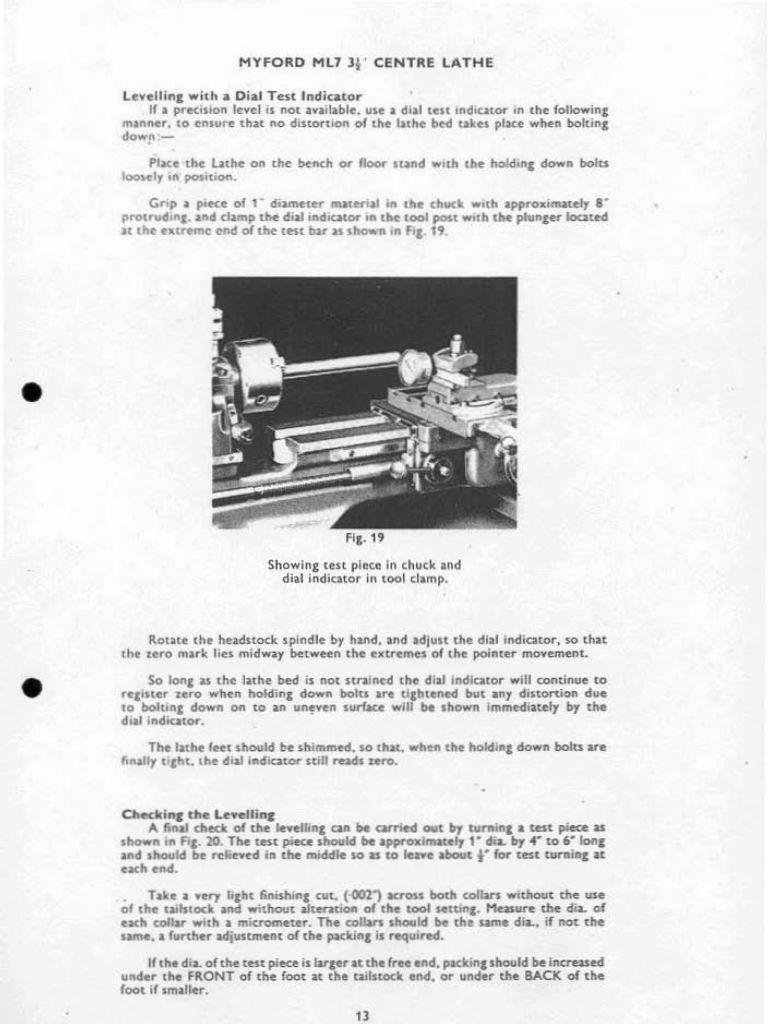Posted by Cedric Blaver on 30/12/2022 09:10:06:
Chuck dist =21.830mm radius =10.915
End dist =21.845mm radius =10.923
Zeroing the dial gauge at the END and rotating the gauge flickers between 0 and 0.01
Then traming down to the chuck end I get a runout of minus 0.10mm.
Please see attached photo of a length of 6mm hex bar.

I assume you did not use the tail stock to turn the 22 mm test bar because that would make the results dependent of the alignment of the tail stock
Correct me if I am wrong your measurements Rotation of the headstock as seen from above:
- You did not use the tail stock during turning
- 0.03 mm/100 mm horizontal misalignment of the head stock + carriage using the facing method, rotation CCW
- 0.10 mm/100 mm horizontal misalignment of the head stock using the turning method, rotation CCW
- You measured a 0.01 mm runout on the turned diameter measured at 100 mm distance of the chuck.
If have checked an online Optimum TU2406 manual but did not find bolts to adjust the headstock. This means that you have to grind/file/sand/scrape the bottom of the headstock to make adjustments. I used a 20 mm worn diamond dremel disk to adjust the headstock of my small lathe. Adjusting takes about half a day. To do that, you have to dismantle the lathe so you can reach the bottom of the headstock. That takes a bout a day.
In short the procedure I followed using the diamond disk and grounded manually:
- Turned the alignment bar and measured the alignment Horizontal and Vertical. You can't remove the bar and chuck during the whole procedure
- Dismantled the lathe
- Removed the headstock, cleaned all surfaces, bolted it on again and measured the alignment
- Removed the headstock and grounded the flat surface of the headstock until all 4 corners of the headstock rest on the lathe bed.
- Bolted on the headstock and measured the alignment Horizontal and Vertical.
- Removed the headstock and grounded the 90° and flat surface of the headstock until it was aligned Horizontal and Vertical. Made measurements without bolting the headstock to the lathe bed.
- Finally bolted the headstock to the lathe bed and did the final measurements.
If you grind the flat surface and both the angled surfaces on the front side, the headstock will bend over and you can adjust a vertical misalignment.
If you grind the front angled surface at the backside and the back angled surface at the frontside, the headstock will turn CW and your misalignment will reduce.
You grind away the top spots. To find a top spot, you mark the bed with a black pentel pen, place the headstock on the bed and move it from left to right and back, 2 mm, a couple of times. The black ink on the headstock indicates the top spot. You will find "scratches" on the lathe bed at the same place.
I used the "same procedure" to correct the misalignment of the tail stock from my bigger lathe.
You can measure the vertical alignment of the headstock by placing the dial on top of the headstock.
Before you do this, you better consult the seller of the machine.
In the netherlands, Optimum has a far better reputation than HBM (my lathe brand).
Hopper.






